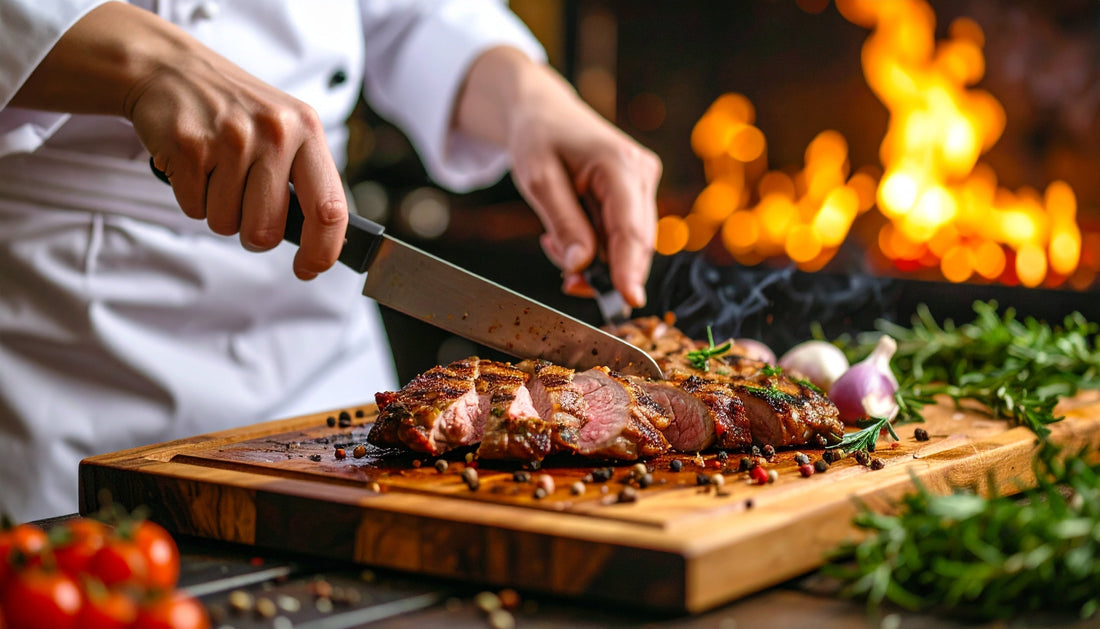
Cutting Board Wood Comparison: Maple, Beech, Walnut, and Cherry Explained
Share
Not all wooden cutting boards are created equal — and the type of wood you choose can dramatically affect your board’s durability, appearance, knife-friendliness, and care routine.
At Kitchen Wing, we focus on four time-tested hardwoods for our handcrafted boards:
Hard Maple
European Beech
American Black Walnut
Cherry
Each offers unique advantages. Here’s how they stack up so you can confidently choose the best board for your kitchen.
Side-by-Side Comparison Chart
Note: All hardness and durability values are averages. Natural wood properties vary depending on growing region, soil nutrients, climate, how the tree was harvested, dried (kiln or air), and how the board is stored over time.
| Feature | Hard Maple | Beech | Walnut | Cherry |
|---|---|---|---|---|
| Janka Hardness | ~1450 lbf | ~1300 lbf | ~1010 lbf | ~995 lbf |
| Knife Friendliness | Moderate | Good | Excellent | Excellent |
| Moisture Resistance | Excellent | Moderate | Good (requires oiling) | Moderate |
| Durability | Very High | High | Medium-High | Medium |
| Grain Texture | Closed, subtle | Fine, flecked | Open, dramatic | Smooth, straight |
| Color & Aging | Pale → Honey Gold | Reddish Tan | Dark Brown → Bronze | Light Red → Amber |
| Maintenance Need | Low-Moderate | Moderate | Moderate | Moderate |
| Lifespan (w/ care) | 20+ years | 15–20 years | 15–20 years | 10–15 years |
Why Wood Properties Vary
Every board is a piece of nature — and nature doesn't manufacture in perfect specs.
Janka ratings are based on averaged laboratory tests, but growing conditions (rainfall, sunlight, soil nutrients) affect the final density and structure.
Post-harvest factors like kiln-drying temperatures, air exposure, and aging time influence how stable or brittle a board becomes.
Even two boards from the same tree can behave slightly differently depending on grain orientation, cut direction, or how they're stored.
That’s why Kitchen Wing carefully selects and conditions each board — and backs it with a lifetime warranty.
What Does the Janka Test Measure?
The Janka test measures the force required (in pounds-force, or lbf) to embed a 0.444-inch steel ball halfway into a piece of wood.
This gives a consistent, objective value for:
How dense or tough the wood is
How well it resists dents, gouges, and compression
How suitable it is for applications like flooring, furniture, or cutting boards
Interpreting Janka Ratings
| Janka Hardness (lbf) | Example Wood Type | Resistance Level |
|---|---|---|
| ~400–800 | Softwoods (Pine, Cedar) | Very soft, dents easily |
| ~900–1000 | Cherry, Alder | Soft hardwood |
| ~1010–1100 | Walnut | Medium hardwood |
| ~1300–1450 | Beech, Maple | Hard, durable |
| ~3000+ | Exotic woods (Ipe, Ebony) | Extremely hard |
Higher number = harder wood.
But remember: harder wood isn’t always better, especially for cutting boards.
Why It Matters for Cutting Boards
Harder woods (like Maple) resist cuts and dents better, meaning the board surface stays smoother and lasts longer.
Softer woods (like Cherry or Walnut) are kinder to knife blades, helping maintain your edge, but may show knife marks sooner.
That’s why cutting board wood selection is a balance — not just about high Janka scores, but how the board performs in real use.
Final Thoughts: Which One Should You Choose?
| If You Want… | Choose… |
|---|---|
| Maximum durability | Hard Maple |
| Warm tone + good performance | Beech |
| Visual luxury + knife care | Walnut |
| Elegance + aging beauty | Cherry |
Whichever you choose, you're investing in craftsmanship, sustainability, and functionality. With the right care, all four species will serve you beautifully for years.
Don’t forget to maintain your board with our Organic Wood Butter — a natural formula to protect, condition, and extend the life of your hardwood surface.
